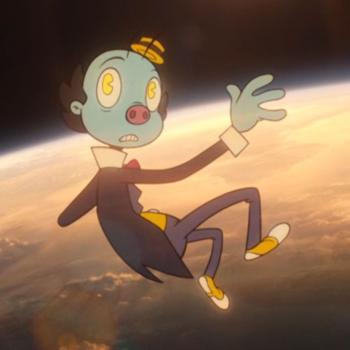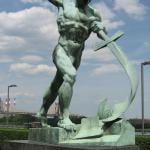One of my recent posts asked just how far back in the show’s history the intersection with religion goes.
I’d like to suggest that the answer is the very first episode – or the second if one considers each half-hour installment an episode.
 In this installment, “The Cave of Skulls,” we encounter early humans struggling with the making of fire – famously credited to the divine Prometheus by the Greeks. The Doctor, with matches (no sonic screwdriver yet) is spotted making fire. As Arthur C. Clarke wrote, “Any sufficiently advanced technology is indistinguishable from magic.” But we also see that without access to technology (whether matches or the TARDIS), the Doctor and his companions are in much the same situation, with only their wits and strength to save them. And so this installment continues a theme introduced in the previous one, namely the relationship between skepticism and faith – with rational incredulity in fact depicted as failing to accurately interpret seemingly miraculous advanced alien science. And so major issues are already being raised about science and technology, as well as about religion.
In this installment, “The Cave of Skulls,” we encounter early humans struggling with the making of fire – famously credited to the divine Prometheus by the Greeks. The Doctor, with matches (no sonic screwdriver yet) is spotted making fire. As Arthur C. Clarke wrote, “Any sufficiently advanced technology is indistinguishable from magic.” But we also see that without access to technology (whether matches or the TARDIS), the Doctor and his companions are in much the same situation, with only their wits and strength to save them. And so this installment continues a theme introduced in the previous one, namely the relationship between skepticism and faith – with rational incredulity in fact depicted as failing to accurately interpret seemingly miraculous advanced alien science. And so major issues are already being raised about science and technology, as well as about religion.
The viewer is of course expected to know that “Orb” (i.e. the Sun) does not choose leaders and give them fire. But are we supposed to notice that the Doctor’s sense of superiority comes from more advanced technology just as it does for the would-be leaders of the tribe? Are we supposed to understand already from this point that the Doctor’s possession of more advanced technology does not necessarily make him trustworthy, much less infallible, as we see him place his companions in harm’s way for the first, and certainly not the last, time?
The very notion of primitive humans and of a time 100,000 BC also challenges one traditional religious viewpoint.
 This part/episode also includes the famous instance of Ian assuming that Susan’s grandfather’s name is Doctor Foreman, to which the Doctor replies “Doctor who?” – leading Ian to later ask “Who is he? Doctor who?” and suggest that the answer to that question might explain what they had experienced.
This part/episode also includes the famous instance of Ian assuming that Susan’s grandfather’s name is Doctor Foreman, to which the Doctor replies “Doctor who?” – leading Ian to later ask “Who is he? Doctor who?” and suggest that the answer to that question might explain what they had experienced.
That is intriguing in light of the recent reemergence of that question to the foreground of the show.
If there is a difference between the mystery of the Doctor’s identity then and now, it is that what was then simply a mystery from a human perspective has been developed into a mystery that is cosmic and universal in nature.
 Finally, let me note that if one is determined to really press the quest for intersection of religion and Doctor Who back as far as it is possible to do so, then one can in fact trace it to the opening credits. The distinctive visual effects for the opening sequence were created using a technique called “howlaround” – essentially the creation of visual feedback in a manner comparable to the much more familiar feedback. The effect was adopted for Doctor Who after being seen in “Amahl and the Night Visitors” – Gian Carlo Menotti’s opera about the magi. And so there is a very real sense that an “unearthly child” inspired the opening credits to the original Doctor Who, which are of course the first element of Doctor Who to appear on TV, ever. An intersection with religion goes back to the absolute very beginning, it would seem.
Finally, let me note that if one is determined to really press the quest for intersection of religion and Doctor Who back as far as it is possible to do so, then one can in fact trace it to the opening credits. The distinctive visual effects for the opening sequence were created using a technique called “howlaround” – essentially the creation of visual feedback in a manner comparable to the much more familiar feedback. The effect was adopted for Doctor Who after being seen in “Amahl and the Night Visitors” – Gian Carlo Menotti’s opera about the magi. And so there is a very real sense that an “unearthly child” inspired the opening credits to the original Doctor Who, which are of course the first element of Doctor Who to appear on TV, ever. An intersection with religion goes back to the absolute very beginning, it would seem.













